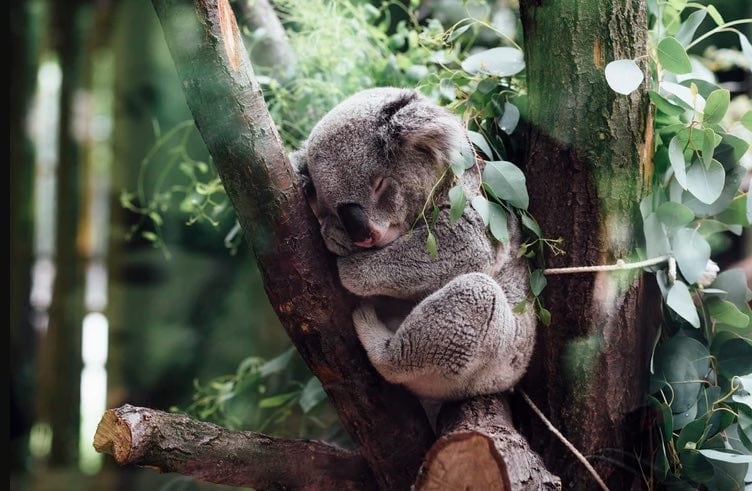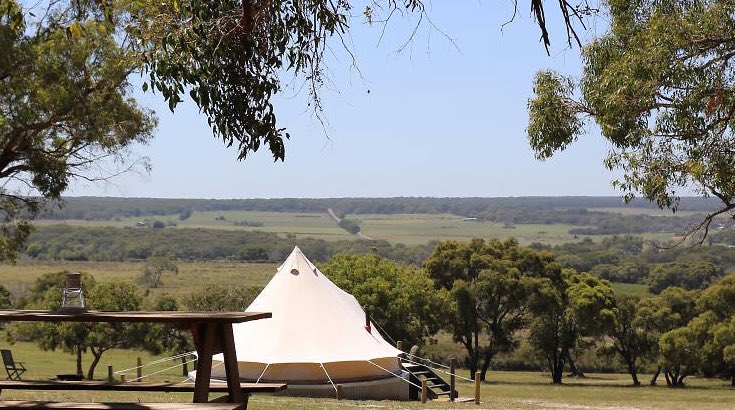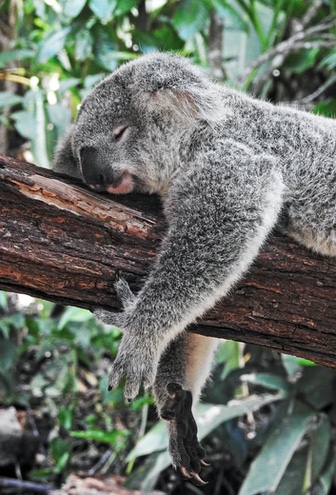Stunning marsupials, koalas are only found in Australia. And while you've probably only seen these secretive animals in prison, there are lots of sites where you can get up close and personal with them in the country down under.
Are you seeking for locations to visit koalas in Melbourne or rural Victoria? Although you could visit one of Melbourne's zoos, we've compiled a list of great spots not far from the city's core where you can view these amazing creatures in their natural environment.
Koalas spend much of their time in the treetops snuggled in the forks of trees and may often be hard to locate amid the branches. However, diligence and a sharp eye will yield your reward. Take along some binoculars if you want a closer look, although they're not required. Try to maintain a receptive ear and watchful sight. Koalas are often regarded to be calm creatures. As a matter of fact, when under pressure or otherwise dissatisfied, they produce low grunting noises.
Koalas have become endangered in New South Wales, therefore unlike kangaroos attempting to observe a natural koala near Sydney is quite hard when compared to Victoria, South Australia and even Queensland. We've only ever encountered really wild regions in Tucki Tucki, but there are plenty of places to give it a go and maybe get fortunate. Alternatively, there are sanctuaries where you may witness rescued or semi-wild koalas.
Raymond Island Koala Trail
Who would have thought to see wild koalas on city streets? There are koalas in the trees above people's houses on Raymond Island because of the special habitat there. To learn more about the 1.2 kilometre koala path, visit the enormous information board in Ferry Park that is plastered with fascinating koala facts. From Paynesville in the Gippsland Lakes region, you may take the ferry to Raymond Island in no time. It's around a 3.5-hour to 4-hour trip from Melbourne's central business district. From Lakes Entrance or Bairnsdale, the trip may be completed in a relaxing day.
We selected this option despite its distance from Melbourne since it is one of the greatest sites to watch koalas. Raymond Island is located three to four hours' drive from Melbourne, but the trek is well worth it since it is home to more than 200 koalas. Raymond Island, which is part of the Gippsland Lakes, is accessible through a boat journey from Paynesville, which is around 300 kilometres from Melbourne's central business district.
You can get to the Island in Wollaston Bay from the mainland or the settlement of Paynesville in a matter of metres. The ferry is a convenient way to go from one place to another; transportation details are provided in the Arrival section.
With the extinction of Victoria's koala population looming at the turn of the 20th century, a small number of the endangered creatures were relocated to Raymond Island, a lush, relatively risk-free area ideal for reproducing.
A huge information board with interesting koala facts and the itinerary for the 1.2km Raymond Island Koala Walk awaits visitors as they arrive at Ferry Park. A factual brochure is also available, with all sales going towards the conservation of koalas.
Given that it takes just 30 minutes to complete, the stroll is perfect for the whole family. However, allot a lot more time so that you may take advantage of the countless picture chances presented by the koalas dozing above. People may stroll along the path between the hours of 6:40 am and 10:00 night daily.
Keep your eyes out for koalas as you make your way back to the boat from Raymond Island's municipality; they are often seen on the move or lounging on sidewalks and streets.
Where on Raymond Island Might One Even Begin to Look for Wildlife?
Everywhere - just keep your eyes open and glance into the trees. But you will have the greatest success along the Raymond Island Koala Trail.
The route is a 1.2-kilometre long circular trek, which initially brings you through a settlement and then through a short piece of woodland. Especially along the forest, we discovered again, and again koalas sitting, sleeping, yawning or occasionally even climbing in the branches.
Some of them were lurking high up in the trees. Others slept barely a few centimetres over our heads on a tree and peered at us sleepy. One thing you can trust us: The lovely tiny creatures don't let anything bother them.
The walk also brings you along the lake and a few little beaches. If the weather is favourable, you may let your legs hang into the water and enjoy the magnificent atmosphere of this lovely Island.
Cape Otway Lightstation
On my journey to the Cape Otway Lightstation, I saw a koala for the first time in the wild while driving down Lighthouse Road. Finding it was not difficult. Driving by, I caught a glimpse of it. Find a safe place to pull over to the side of the road before peering into the canopy. The Great Otway National Park is home to the Cape Otway Lighthouse. Take a trip down the world-famous Great Ocean Road, which begins in Melbourne.
Kennett River Koala Walk
You'll be driving and walking down Grey River Road in Kennett River for around 45 minutes. A 30-minute hike through the Otway rain forest is included. There is a stretch of the journey that is on an unpaved road. In general, koalas sleep throughout the day and awaken in the late afternoon. The Kennett River region is fantastic for koala sightings since it is home to hundreds of these adorable marsupials. Located in the Great Otway National Park is the Kennett River. Notes and a map of the park may be downloaded by clicking here.
A tiny town and river of the same name may be found in Victoria, Australia, near the Otway Coast. There is a settlement there, and it's right on the Great Ocean Road, 174 kilometres west of Melbourne.
Great Otway National Park, the seashore, and surfing are some of the area's most famous attractions.
Wild koalas may be seen at a two-kilometer wide section of woodland off the Great Ocean Road's Grey River Road, where the animals relax in the eucalyptus trees while greeting visitors or napping. Awesome creatures!
A road surrounded with eucalyptus trees may be seen near the Great Ocean Road community of Kennett River.
In the wild, koalas are possible to see there. Numerous sightseers make it difficult to lose the path. The cockatoos and parrots that stroll around on the ground like they own the place and can be given scraps from the adjoining café were much more popular during our stay.
As a result, we were able to focus only on our mission of finding koalas on the Kennet River Koala Walk.
Tower Hill Wildlife Reserve
Keep your eyes out for koalas, as well as kangaroos, wallabies, emus, echidnas, and a variety of birds. Several trails traverse the reserve, which is centred on Tower Hill Lake. Although seeing a koala may not be possible, your vacation is sure to be worthwhile anyway.
French Island National Park
An estimated 1,500 koalas make their home on the island. Koalas from French Island are utilised to repopulate mainland populations since they are disease-free.
At French Island National Park, you may see a koala colony that numbers around 1,500 animals. As a result of French Island's abundance of koalas, some were relocated to Kinglake National Park, which had suffered a significant decline in its koala population due to recent bushfires.
Getting to Stony Point from Melbourne's central business district takes a little over an hour by car. The natural beauty of French Island may be reached after a quick 10-minute boat journey.
All hikes begin at the Tankerton shoreline, where the boat will deposit you, and go through pristine countryside. No matter whether you choose a short trip or a long day of walking, you will be treated to sights of dozing koalas and eager joeys exploring their surroundings from high in the trees.
You may spend the night at Fairhaven Campground on French Island if you just cannot bear to leave the tranquil setting. Fairhaven Campground is a free, beautiful place to spend the night among the dunes behind the beach, about 5 kilometres from the ferry station. There is no cost to camp among the koalas, but you must reserve one of the six available pits in advance.
Werribee Gorge State Park
Not all trails in the park are kid-friendly because of the lack of paved or gravel paths meant to preserve the area's natural nature. In any case, the Short Circuit Walk leads to the Meikles Point Picnic Area and the Quarry Picnic Area, both of which provide lots of picnic spots and rock pools for paddling.
Coolart Historic Area and Wetlands
Although koalas are uncommon in Coolart, it is possible to see one if you keep your eyes peeled throughout the day. If you are unable to locate a koala, please do not get disheartened; there is plenty more to see and do in this area. There is a lot of birdlife in the marshes, and you may see it from a bird hide.
The formal gardens, marsh regions, lagoons, and coastal forests may all be explored on foot along the well-maintained paths that encircle the old house.
Brisbane Ranges National Park
Phillip Island
Phillip Island, located 90 minutes south-east of Melbourne, is a popular destination for those on the lookout for koalas in the area. Depending on your location in Melbourne, a day excursion to Phillip Island is possible. However, it is most often visited on weekends.
There are many koalas to see on Phillip Island, and although they may get lost in the shuffle compared to the island's more famous inhabitants, penguins, the koalas are worth the trip.
The Koala Reserve is a one-of-a-kind attraction since it allows guests to get up close and personal with koalas in their natural environment through elevated boardwalks. Additionally, visitors may participate in a ranger-led "Koala Eco-Explorer Tour" to learn more about the koalas and their unique lifestyle.
Healesville Sanctuary
Free-roaming koalas are only one of the numerous attractions at Healesville Sanctuary, a wildlife park in the beautiful Yarra Valley an hour's drive from Melbourne.
Visitors are able to get up close to the adorable koalas by strolling along designated boardwalks through the wilderness, much to the setup on Phillip Island.
In addition to kangaroos, wallabies, dingoes, and emus, Healesville Sanctuary is the place to go to see other cute species.
You may visit the sanctuary every day of the week between the hours of 9 AM and 5 PM. Prices range from $36 for adults to $19 for those under the age of 16. While adults pay full price, children under 12 go in free on weekends and holidays. Koala encounters may be booked separately.
Cape Otway, Victoria
The Cape Otway Peninsula is another stunning location that is koala-safe. The little, rarely-visited beauty of Cape Otway is only a short drive west of Kennett River.
Cape Otway is a landmark on Australia's world-famous Great Ocean Road, yet most visitors to the area seldom stop to explore it.
Although it is part of the Great Ocean Road, the westernmost point of Australia is not visited by nearly as many sightseers as the other, more well-known stops along the route.
This is just one more incentive to investigate this quiet, unassuming, and somewhat isolated sanctuary.
As the southernmost point of the Great Ocean Road, Cape Otway is a part of the Great Otway National Park. From the Great Ocean Route, you may take a paved road that is 14 kilometres long all the way to Cape Otway.
The trip itself is an adventure, taking you first through rolling green hills and then deep into the temperate rainforest of Great Otway National Park, home to seemingly countless towering eucalyptus trees.
It's little surprise that koalas consider this area a genuine and mostly disturbance-free paradise. Koalas may be spotted in greater numbers there than in any other area in Australia. Shade woods are a welcome sight in the scorching summer months. You may go on a variety of hikes, both large and little, through the stunning rainforest and along the shore.
The oldest lighthouse on the Australian mainland is located at the tip of Cape Otway. As early as 1848, the Cape Otway Lightstation began alerting mariners of the perilous coastline, where several ships had been sunk in the past.
Between the Southern Ocean and the Bass Strait is where you'll find Cape Otway. From Europe, the majority of ships stopped here on route to Melbourne. The lighthouse on this headland was typically the first sight of Australia for many newcomers.
There are 90 metres between the ground and the top of the lighthouse. The vista across the rocky shore from this vantage point is breathtaking. Whales may be seen from June through October.
Conclusion
It is possible to see them in a number of locations in Melbourne and rural Victoria. There are sanctuaries in New South Wales where you can see endangered koalas. There are more than 200 koalas living on Raymond Island, located three to four hours from Melbourne, but the journey is well worth it. The route is a 1.2-mile circular trek that begins in a town and ends in a forest. Hundreds of koalas live in the Kennett River region, making it a great place for koala sightings.
From Melbourne, set out on a journey along the Great Ocean Road, one of the world's most famous routes. For an additional fee, guests can take a 30-minute Otway rainforest walk. The island of French Island is home to an estimated 1,500 koalas. As they are disease-free, koalas from French Island are being used to repopulate mainland populations. Bushfires had decimated the koala population in Kinglake National Park, so some of the animals were relocated there.
Guests at the Koala Reserve can get up close and personal with koalas in their natural habitat, which makes it a unique attraction. Healesville Sanctuary is an hour's drive from Melbourne in the picturesque Yarra Valley. The Great Ocean Road ends at Cape Otway, which marks the southernmost point of the route. Cape Otway's lighthouse, Australia's oldest, can be found there. The Great Otway National Park's temperate rainforest is home to koalas and eucalyptus trees that tower over the landscape.
Content Summary
- Australia is the only place in the world where you can see koalas in their natural habitat.
- Look no further than Melbourne and rural Victoria for koala sightings.
- There are more than 200 koalas living on Raymond Island, located three to four hours from Melbourne, but the journey is well worth it.
- Small numbers of the endangered Koalas were relocated in the early 20th century to Raymond Island, a lush and relatively risk-free area ideal for reproduction, as the extinction of Victoria's Koala population approached.
- However, the Raymond Island Koala Trail is where you'll have the most success.
- Lighthouse at Cape Otway, Victoria
- When I was driving along Lighthouse Road on my way to Cape Otway Lightstation, I saw my first koala in the wild.
- The Cape Otway Lighthouse is located in Great Otway National Park.
- The Kennett River Koala Trail
- Grey River Road in Kennett River will take you about 45 minutes to drive and walk.
- The Kennett River is located in the Great Otway National Park.
- The koala population at French Island National Park is estimated to be around 1,500 animals.
- It is possible to take a day trip to Phillip Island from Melbourne, depending on your location.
- Victoria's Cape Otway
- Another beautiful koala-safe location is the Cape Otway Peninsula.
- The Great Otway National Park includes Cape Otway, the southernmost point of the Great Ocean Road.
- Cape Otway's lighthouse, Australia's oldest, can be found there.
FAQs About Melbourne
Koalas live in the eucalyptus forests of southeastern and eastern Australia. When not sleeping, they're usually eating. They rely on the eucalyptus tree for both habitat and food.
The fur on a koala's bottom has a 'speckled' appearance which makes koalas difficult to spot from the ground. The easiest way to discover a koala resting in a tree involves looking down, not up. While a koala sitting in the crown of a tree can be difficult to see, its droppings on the ground are quite obvious.





